
Who is the Artist Who Changed the Rules of Street Art?
Have you ever been intrigued by the mysterious appeal of Banksy, the most influential and famous street artist of all time, whose identity is still a mystery? Since the 1990s, this artist has been transforming the urban landscape around the world with his distinctive stencil technique. The speed of this methodology allows him to remain hidden, both from the general public and the authorities.
Here are Banksy’s works, what is their significance and where to see them.
Banksy’s works: significance and whereabouts
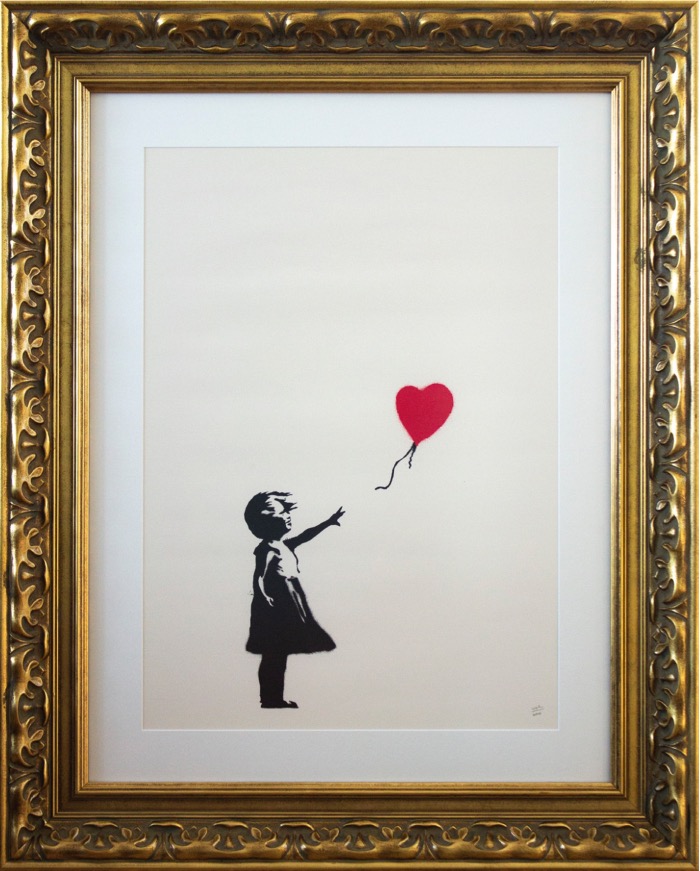
Banksy, Girl with balloon
Banksy began his artistic career on the streets of Bristol, quickly becoming an influential member of the local underground culture. While still a teenager, he joined several street artist crews, including Inkie. He began spreading political and social messages through graffiti on trains, often risking arrest. During one of these artistic forays, Banksy discovered the stencil technique, which became his trademark.
THE STENCIL TECHNIQUE: SPEED AND EXPRESSIVENESS
Stenciling involves using a cut pattern to spray paint onto a surface, allowing Banksy to complete a work in just 15-20 minutes. The stencil also offers the flexibility to reproduce the same design on various media.
His early works already displayed the charisma, personality and black humour that characterise him today.
With the advent of the new millennium, Banksy began to receive international recognition. Among his most significant works are the graffiti he has created on the wall separating the West Bank from Israel, an artistic protest against what he considers a violation of international law.
MEANING AND RECURRING THEMES IN BANKSY’S WORKS
Rats, monkeys, children and police forces populate his creations, which are often charged with political and social messages. For example, his first large mural, ‘The Mild Mild West’, depicts a teddy bear throwing a Molotov cocktail at riot police, immediately becoming a powerful symbol for the local community.
In addition to the murals, Banksy has created a number of works on canvas and prints, openly defying the conventions of the art world. For example, in a bold move, he sold authentic works in Central Park in 2013 for only $60 each.
These same works were later authenticated and sold for tens of thousands of dollars.
Here are the Banksy works you need to know about and where you can see them:
GIRL WITH BALLOON (THERE IS ALWASYS HOPE), 2002
The work first appeared in London on the now removed Waterloo Bridge wall.
The image is simple but straightforward: a gust of wind robs a little girl of her red heart-shaped balloon and is probably Banksy’s most successful work. In 2018, a reproduction of the work was used for an action against the art system. During a Sotheby’s auction, the work fetched £1.4 million, but a shredder hidden in the frame went off, partially destroying it. The work is privately owned but is reproduced in a variety of ways and media: from mugs to pillows, from bed sheets to school exercise books. Some have gone so far as to tattoo the work.
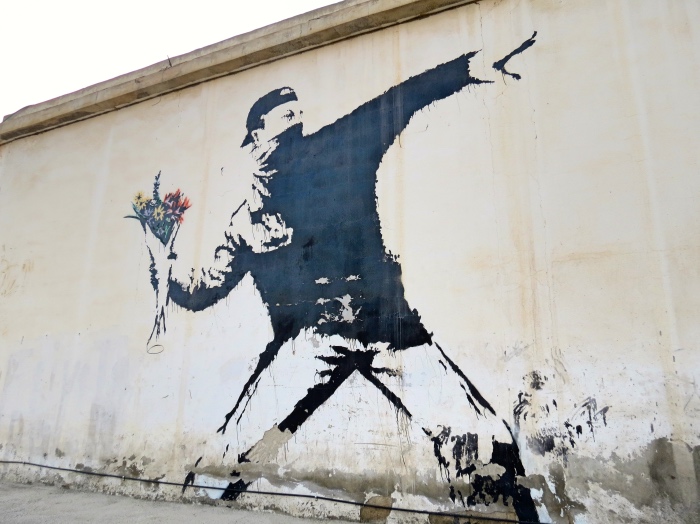
RAGE: THE FLOWER THROWER
RAGE: THE FLOWER THROWER, 2003
The subject of the work was first painted on the wall bordering the road from Jerusalem to Bethlehem, however, it has been re-proposed by the artist several times. The first version on canvas appeared in 1998 on the occasion of a temporary exhibition in Bristol.
The protagonist appears as a violent protester caught in the moment of throwing, perhaps an incendiary bottle. On closer inspection, however, we realise that he is only holding a bouquet of flowers and thus the meaning of his gesture changes completely.
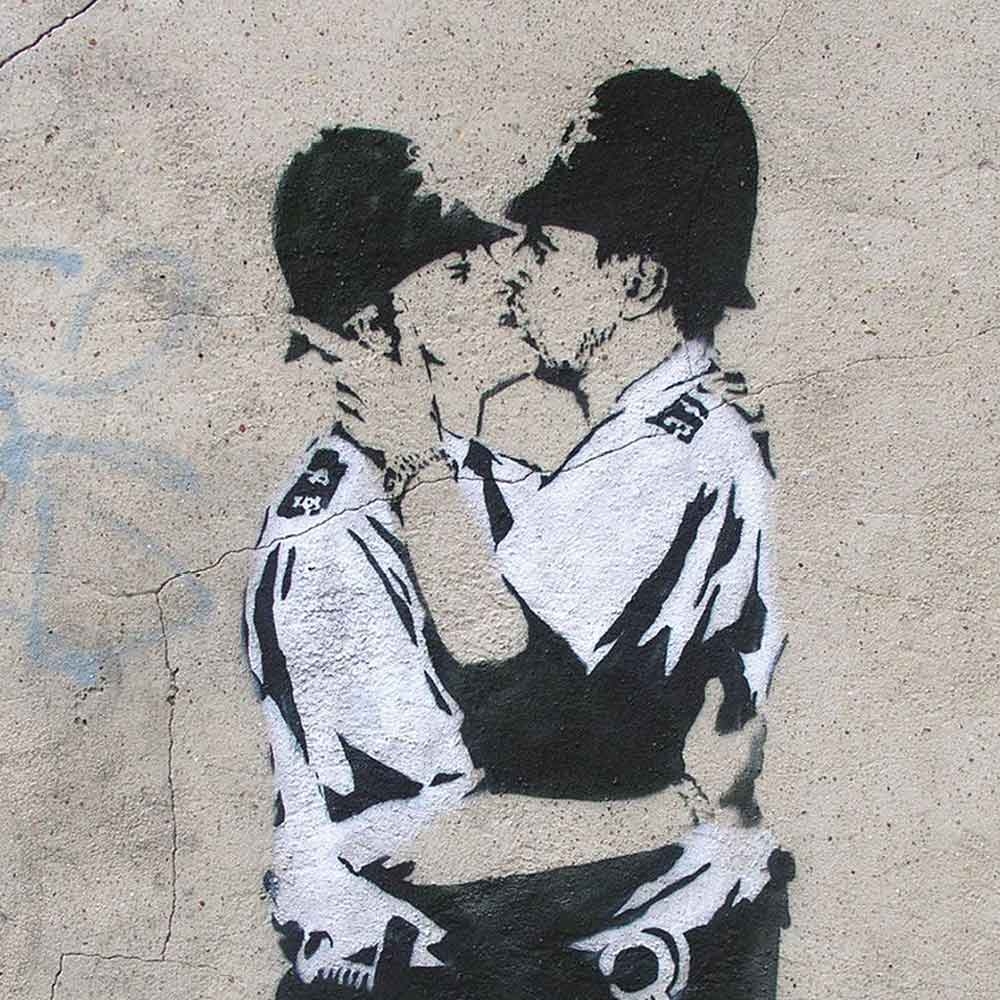
KISSING COPPERS
KISSING COPPERS, 2004
Attacking authority and its symbols seems to be Banksy’s favourite sport as he chooses to depict the passionate kiss between two British policemen on the wall of a Brighton pub.
The work is reminiscent of the famous mural in the East side Gallery in Berlin in which Brezhnev and Honecker exchange a passionate kiss. In reality it is only a reference as here the reference is probably to the fact that in England homosexuals were not allowed into the police force until 2000, while at Pride they have only been allowed to attend in uniform since 2003.
The work was taken down in 2011 and put up for auction.Three years later, a copy was placed on the wall of the pub.
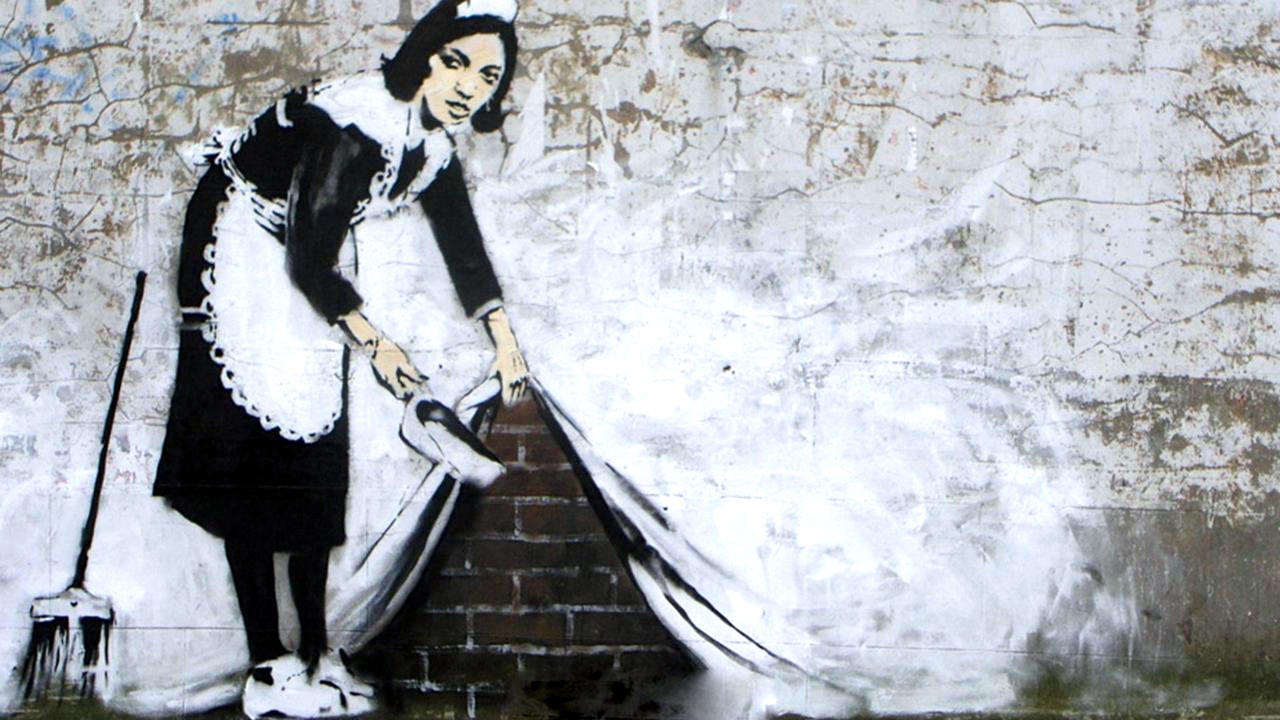
SWEEPING IT UNDER THE CARPER
SWEEPING IT UNDER THE CARPER, 2006
Banksy depicts a waitress in her uniform on the wall of the White Cube gallery in London. He seems to want to provoke us by stating that people often prefer to ignore problems rather than try to solve them.
The work only remained on the gallery wall for a month, then was wiped off with a coat of paint as White Cube immediately removes any graffiti that appears on its walls, however the work survives in thousands of reproductions and even though the original has been removed, the idea remains and continues to spread around the world.
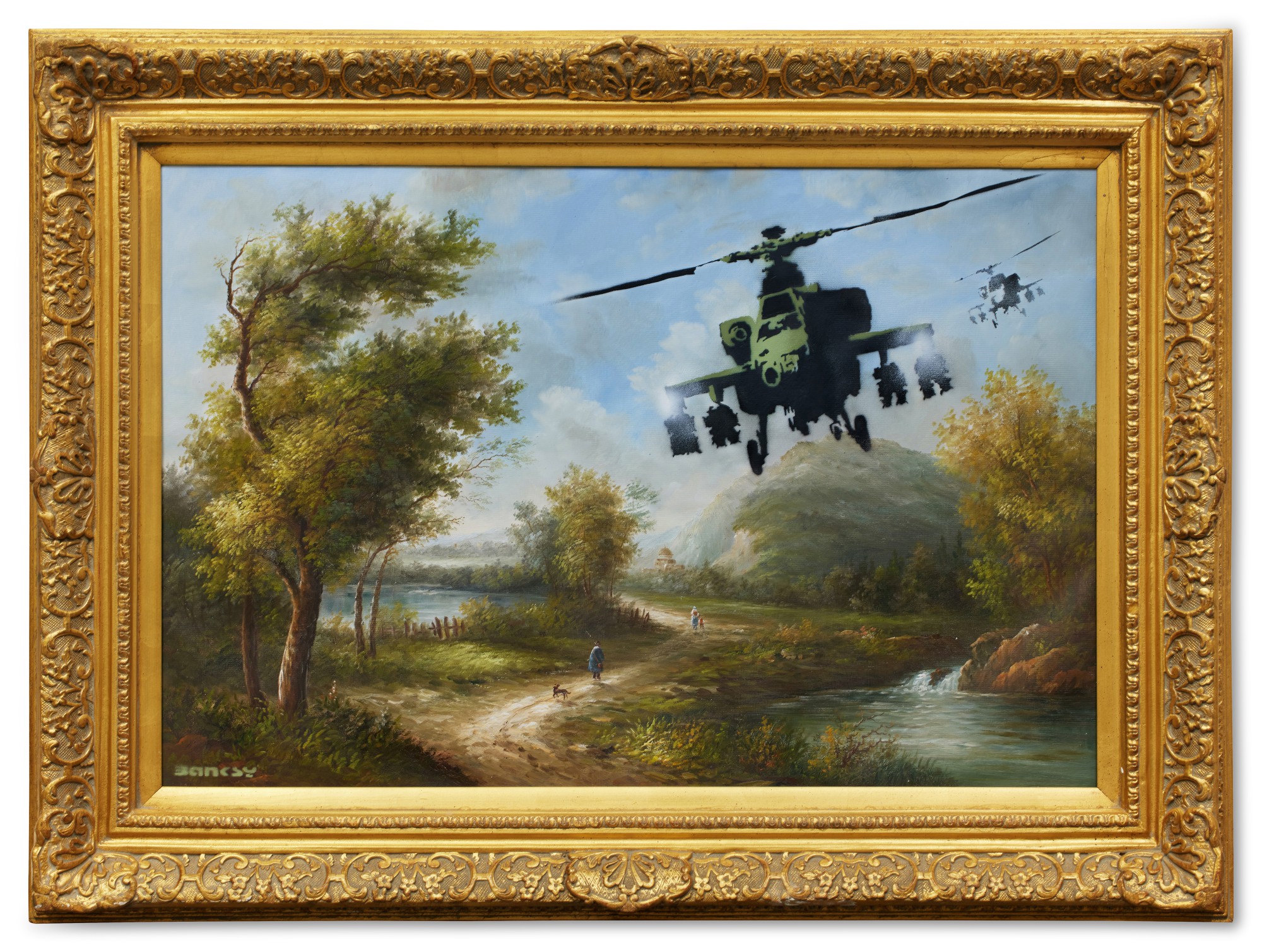
CRUDE OLIL
CRUDE OLIL (SERIE), 2009
Banksy continually plays with references not only from the contemporary world but also from art history.he creates a series of works consisting of eighteenth-century-inspired paintings in which completely different elements are inserted into a quiet, peaceful landscape, leaving little room for irony.
This is not a new idea but is borrowed from Asger Jorn, who used to go to flea markets to salvage canvases of little value and intervene himself by drawing, for example, a moustache on the portrait of a young girl or making doodles inside the work.
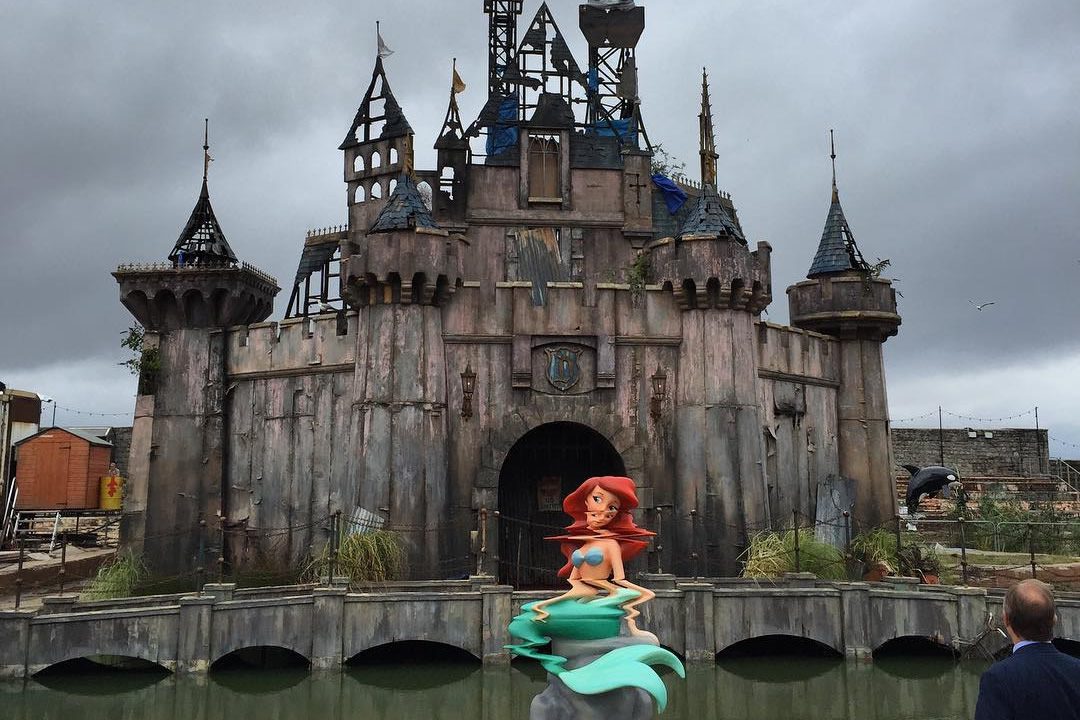
DISMALAND BEMUSEMENT PARK
DISMALAND BEMUSEMENT PARK, 2015
From 21 August to 27 September 2015, anyone passing through Weston-super-Mare could have visited Banksy’s imagined dystopian version of an amusement park.
It is a family theme park that is actually not suitable for children and makes fun of the Disney amusement parks. When Banksy’s park closed there were 150,000 visitors with a turnover of £20 million.The dismantled structures were reused to build housing in the so-called ‘Calais Jungle’, the place where migrants wait for a visa or just an opportunity to enter Britain.
BREXIT, 2017
When Britain decided, in a referendum, to leave the European Union, Banksy decided to comment on the event in his own way.he created a mural ad over in which he inserts a worker while he is intent on chiselling away one of his stars from the flag of Europe.
The work was erased but still remains in everyone’s memory and in hundreds of reproductions around the world.
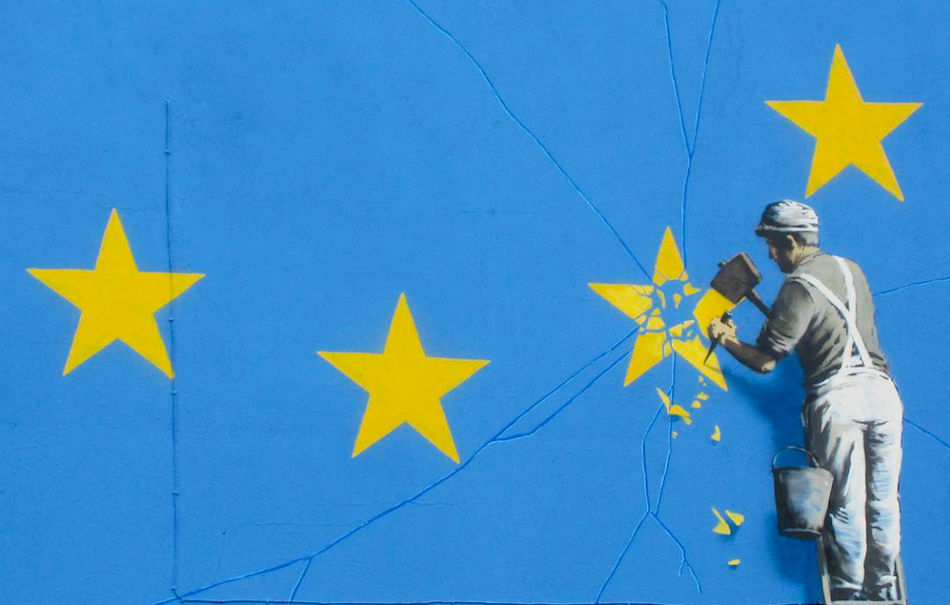
BREXIT
WHO BANKSY REALLY IS
Many theories circulate around Banksy’s identity. Some suggest that he could be a woman, others that he could be an artist collective or even the musician Robert Del Naja of Massive Attack. However, anonymity seems to be an integral part of his strategy, contributing to his aura and the appeal of his works.
Not knowing Banksy’s identity not only protects him legally, but also adds an additional element of mystery and fascination that has helped cement his status and the desirability of Banksy’s works in the contemporary art world.
What is certain is that his works, despite the fact that many are no longer visible where they first appeared, have a wide circulation around the world and do not cease to question and provoke us.

